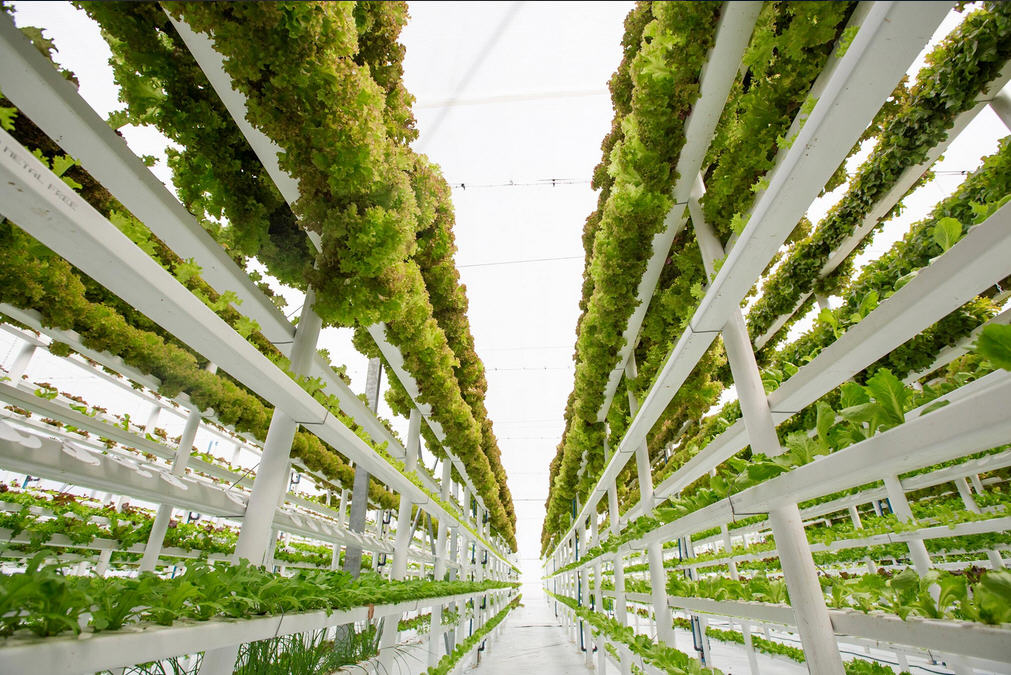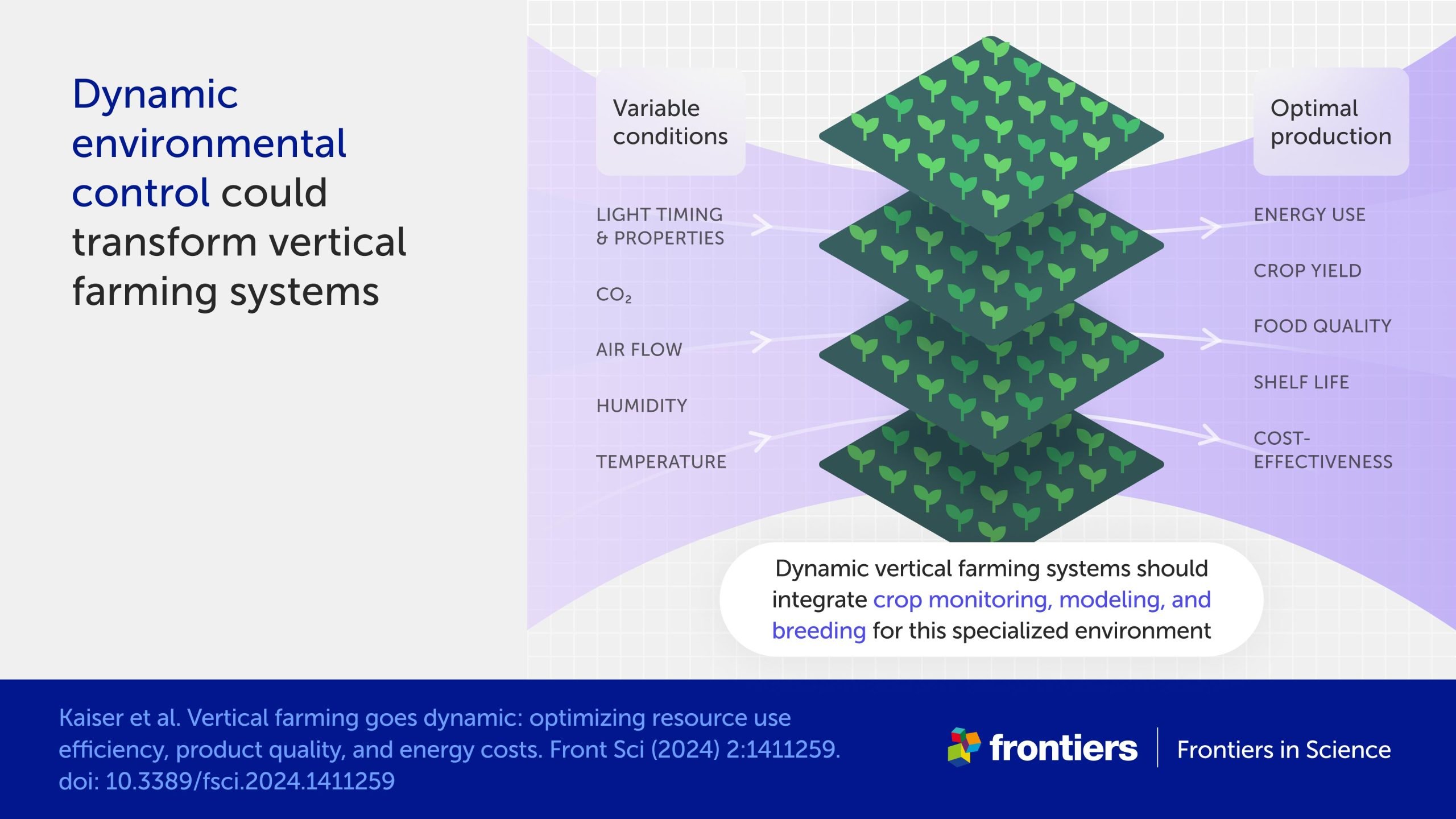博文
垂直农业如何改变食物生产
 精选
精选
||
垂直农业如何改变食物生产
诸平
据“前沿”(Frontiers)2024年9月24日提供的消息,面对耕地减少、世界人口增加,僧多粥少的矛盾日显突出,为未来提供食物的出路在何方?垂直农业(Vertical Farming)能破解这一难题吗?垂直农业是如何改变食物生产的(Feeding the Future: How Vertical Farming Could Transform Food Production)?
研究人员探索室内农场的动态环境控制如何帮助我们为不断增长的人口提供营养、高质量、当地种植的水果和蔬菜。垂直农业有望彻底改变我们在城市和极端环境中生产食物的方式,通过动态环境控制优化植物生长,特别是智能照明,根据电力成本和植物需求进行调整。研究人员强调了这些系统在提高食品质量和可持续性的同时减少能源使用的潜力。
可持续农业的创新方法(Innovative Approaches to Sustainable Agriculture)
在我们日益拥挤的世界中,确保每个人都有足够的食物需要创新的方法。垂直农业是一种可行的选择,它的方法是在室内密集种植植物。其广泛采用的主要障碍在于解决植物生长所需的照明的高成本和能源需求。科学家们现在发现,调整光线以适应每种作物的独特需求,可以促进更强壮、更健康的生长,同时减少能源消耗。相关研究结果于2024年9月24日已经在《科学前沿》(Frontiers in Science)杂志网站在线发表——Elias Kaiser, Paul Kusuma, Silvere Vialet-Chabrand, Kevin Folta, Ying Liu, Hendrik Poorter, Nik Woning, Samikshya Shrestha, Aitor Ciarreta, Jordan van Brenk, Margarethe Karpe, Yongran Ji, Stephan David, Cristina Zepeda, Xin-Guang Zhu, Katharina Huntenburg, Julian C. Verdonk, Ernst Woltering, Paul P. G. Gauthier, Sarah Courbier, Gail Taylor, Leo F. M. Marcelis. Vertical farming goes dynamic: optimizing resource use efficiency, product quality, and energy costs. Frontiers in Science, 2024, 2. DOI: 10.3389/fsci.2024.1411259. Publication date: 24 September 2024 .https://doi.org/10.3389/fsci.2024.1411259
这篇文章的第一作者埃利亚斯·凯泽(Elias Kaiser)博士说:“垂直农业系统的最大好处是,健康食品可以在离消费者更近的地方种植,否则这些地方是不可能的:大城市、沙漠,以及一年中大部分时间都寒冷黑暗的地方。但是,最大的挑战是与电力使用相关的成本。”
垂直农业的能源效率(Energy Efficiency in Vertical Farming)
许多垂直农业系统是在恒定的环境条件下运行的,这需要大量昂贵的电力来维护。科学家们的分析表明,这些苛刻的条件是不必要的:他们建议,通过动态环境控制,我们可以实现更具成本效益、也能培育出更健康植物的垂直农业。
研究报告的资深作者、荷兰瓦赫宁根大学(Wageningen University, Wageningen, Netherlands)的里奥·马塞利斯教授(Prof Leo Marcelis)说:“我们的动机是植物在昼夜节律和发育时间尺度上表现出的节律,这需要它们的生长环境定期调整,以完美地引导它们的生长。我们概述了一种策略,利用植物生理学知识、新的传感和建模技术以及专门为垂直农业系统培育的新品种。”
植物生长利用技术(Harnessing Technology for Plant Growth)
由于植物的生物功能受到温度变化、光波长和大气中CO2含量等环境条件的严重影响,操纵环境使垂直农业系统能够操纵植物的发育。照明是一个关键变量;所有的植物都需要光来进行光合作用,不同的光波长对不同的植物有不同的影响。这个变量对电价也特别敏感,因此提供了提高效率的机会。
里奥·马塞利斯解释说:“电价的波动可以利用垂直农业系统的优势,在更便宜的时候使用更多的电量。”
作者创建了一个测试智能照明的模型,旨在保持植物在一天中稳定的光合作用能力,同时仍然降低电力成本。他们发现,一种优化算法可以通过改变光的强度,在不影响植物碳固定的情况下,将电力成本降低12%。
然后,他们测试了不同的光照强度是否会影响菠菜等叶类植物的生长,这些植物通常生长在垂直农场中,结果发现没有负面影响。即使当植物受到不规则变化的光强而不是可预测的规则模式的影响时,这一结论仍然成立。
为未来的农业做准备(Preparing for the Future of Farming)
在垂直农业能够帮助养活世界人口之前,还有其他关键问题有待解决。
埃利亚斯·凯泽警告说:“许多提出的解决方案还没有在垂直农场所代表的更大规模上进行过测试,它们可能已经在单株作物水平上得到了证明,但还没有在整体作物水平上得到证明。”
根据工厂的需要动态调整空气流速、温度和CO2,可能会提供最小化电力成本的机会。农民将需要合适的传感器和模型来帮助他们监测和调整环境,以及为垂直农业培育的新品种。这些品种可以利用在庇护条件下当地生产的潜力,专注于更好的营养和感官品质,而不是健壮性或保质期。需要更多的研究来校准所有这些变量,并在优质和高产作物之间取得适当的平衡。
里奥·马塞利斯说:“在垂直农场中,所有的生长条件都可以精确控制,这对优化产量、质量和资源利用效率非常重要。然而,保持它们不变的技术可能性并不意味着保持它们不变是最好的解决方案。一旦建立了动态环境控制,能源的使用和使用能源的成本都可以大大减少,从而提高垂直农场的盈利能力和可持续性。”
参与此项研究的有来自荷兰瓦赫宁根大学、美国佛罗里达大学盖恩斯维尔分校(University of Florida, Gainesville, FL, United States)、德国于利希研究中心(Forschungszentrum Jülich GmbH, Jülich, Germany)、澳大利亚麦考瑞大学(Macquarie University, Sydney, NSW, Australia)、西班牙巴斯克大学{University of the Basque Country (UPV/EHU), Bilbao, Spain}、中国科学院上海植物生理与生态研究所(Shanghai Institute of Plant Physiology and Ecology, Chinese Academy of Sciences, Shanghai, China)、澳大利亚昆士兰大学(The University of Queensland, St Lucia, QLD, Australia)、德国弗莱堡大学(University of Freiburg, Freiburg, Germany)、美国加州大学戴维斯分校(University of California, Davis, Davis, CA, United States)的研究人员。
本研究得到了荷兰研究理事会{Dutch Research Council(NWO), NWO Crossover grant 17626} 、AMS研究所(AMS Institute)、拜耳公司(Bayer)、博斯曼·范·扎尔公司(Bosman van Zaal)、Certhon、Fresh Forward、荷兰格露丹(Grodan)、Growy、Own Greens/Vitroplus、普瑞维亚(Priva)、Signify、Solynta、联合利华(Unilever)和万贝尔根·科帕建筑事务所(Van Bergen Kolpa Architects)以及粮食和农业基金会(Foundation for Food & Agriculture Research简称FFAR)资助的TTW透视计划——“Sky High”(TTW Perspectief programme “Sky High”) 的支持。也得到了梅里安基金(Merian Fund for the NWO-CAS projects “Twinergy” and “Greenfarm”)、西班牙巴斯克研究经费(The research grant IT1461-22 provided by Basque Country, Spain)、德国研究基金会{Deutsche Forschungsgemeinschaft (DFG, German Research Foundation) under Germany's Excellence Strategy (CIBSS – EXC-2189 – Project ID 390939984)}的资助或者支持。
上述介绍,仅供参考。欲了解更多信息,敬请注意浏览原文或者相关报道。
Vertical farming is considered to be a key enabler for transforming agrifood systems, especially in or nearby urbanized areas. Vertical farming systems (VFS) are advanced indoor cropping systems that allow for highly intensified and standardized plant production. The close control of environmental parameters makes crop production stable and repeatable, ensuring year-round uniform product quality and quantity irrespective of location. However, due to continuous changes in plant physiology and development, as well as frequent changes in electricity prices, the optimum conditions for crop production and its associated costs can change within days or even minutes. This makes it beneficial to dynamically adjust setpoints for light (intensity, spectrum, pattern, and daylength), CO2, temperature, humidity, air flow, and water and nutrient availability. In this review, we highlight the beneficial effects that dynamic growth conditions can have on key plant processes, including improvements in photosynthetic gas exchange, transpiration, organ growth, development, light interception, flowering, and product quality. Our novel findings based on modeling and experimentation demonstrate that a dynamic daily light intensity pattern that responds to frequent changes in electricity prices can save costs without reducing biomass. Further, we argue that a smart, dynamic VFS climate management requires feedback mechanisms: several mobile and immobile sensors could work in combination to continuously monitor the crop, generating data that feeds into crop growth models, which, in turn, generate climate setpoints. In addition, we posit that breeding for the VFS environment is at a very early stage and highlight traits for breeding for this specialized environment. We envision a continuous feedback loop between dynamic crop management, crop monitoring, and trait selection for genotypes that are specialized for these conditions.
https://blog.sciencenet.cn/blog-212210-1452989.html
上一篇:将太阳能储存在分子中并将其转化为热能
下一篇:科学家们解决了一个50年的难题:石墨的振荡舞蹈

